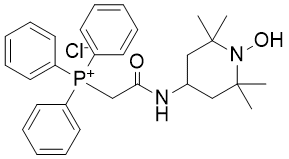| Cas No.: | 1334850-99-5 |
| Chemical Name: | Mito-TEMPO |
| Synonyms: | (2-(2,2,6,6-Tetramethylpiperidin-1-oxyl-4-ylamino)-2-oxoethyl)triphenylphosphonium chloride;Mito-TEMPO;[2-[(1-Hydroxy-2,2,6,6-tetramethylpiperidin-4-yl)amino]-2-oxoethyl]-triphenylphosphanium Chloride |
| SMILES: | [Cl-].[P+](C1C=CC=CC=1)(C1C=CC=CC=1)(C1C=CC=CC=1)CC(NC1CC(C)(C)N(C(C)(C)C1)O)=O |
| Formula: | C29H36ClN2O2P |
| M.Wt: | 511.043 |
| Purity: | >98% |
| Sotrage: | 2 years -20°C Powder, 2 weeks 4°C in DMSO, 6 months -80°C in DMSO |
| Description: | Mito-TEMPO is a mitochondria-targeted superoxide dismutase mimetic with superoxide and alkyl radical scavenging properties. |
| In Vivo: | Mito-TEMPO (MT) greatly attenuates the increase in ALT activities and reduces the areas of necrosis at both time points, indicating that the protection by Mito-TEMPO is sustained until at least 24 h post-APAP. Mito-Tempo could induce secondary apoptosis in the late phase of APAP hepatotoxicity. Mito-Tempo induces secondary apoptosis after APAP overdose by inhibition of RIP3[1]. |
| Animal Administration: | Mice[1] Male C57BL/6J mice (8-12 weeks) and RIP3-deficient mice (C57BL/6N background) are used throughout the study. The mice are acclimated before experiments with free access to diet and water. Overnight-fasted mice (16-18 h) are treated i.p. with 300 mg/kg APAP dissolved in warm saline. Some mice are treated with 200 mg/kg APAP in experiments evaluating effect of RIP3 deficiency. A dose of 20 mg/kg Mito-Tempo dissolved in saline is administered i.p. 1.5 or 3 h after APAP. Some mice are subsequently treated (i.p.) with 10 mg/kg ZVD fmk dissolved in Tris-buffered saline or vehicle 2 h after APAP. To mimic the clinical care of APAP-overdose patients, some mice receive the antidote NAC (i.p., 500 mg/kg) at 1.5 or 3 h after APAP overdose[1]. |
| References: | [1]. Du K, et al. Mito-tempo protects against acute liver injury but induces limited secondary apoptosis during the late phase of acetaminophen hepatotoxicity. Arch Toxicol. 2018 Oct 15. |

 To enhance service speed and avoid tariff delays, we've opened a US warehouse. All US orders ship directly from our US facility.
To enhance service speed and avoid tariff delays, we've opened a US warehouse. All US orders ship directly from our US facility.




















